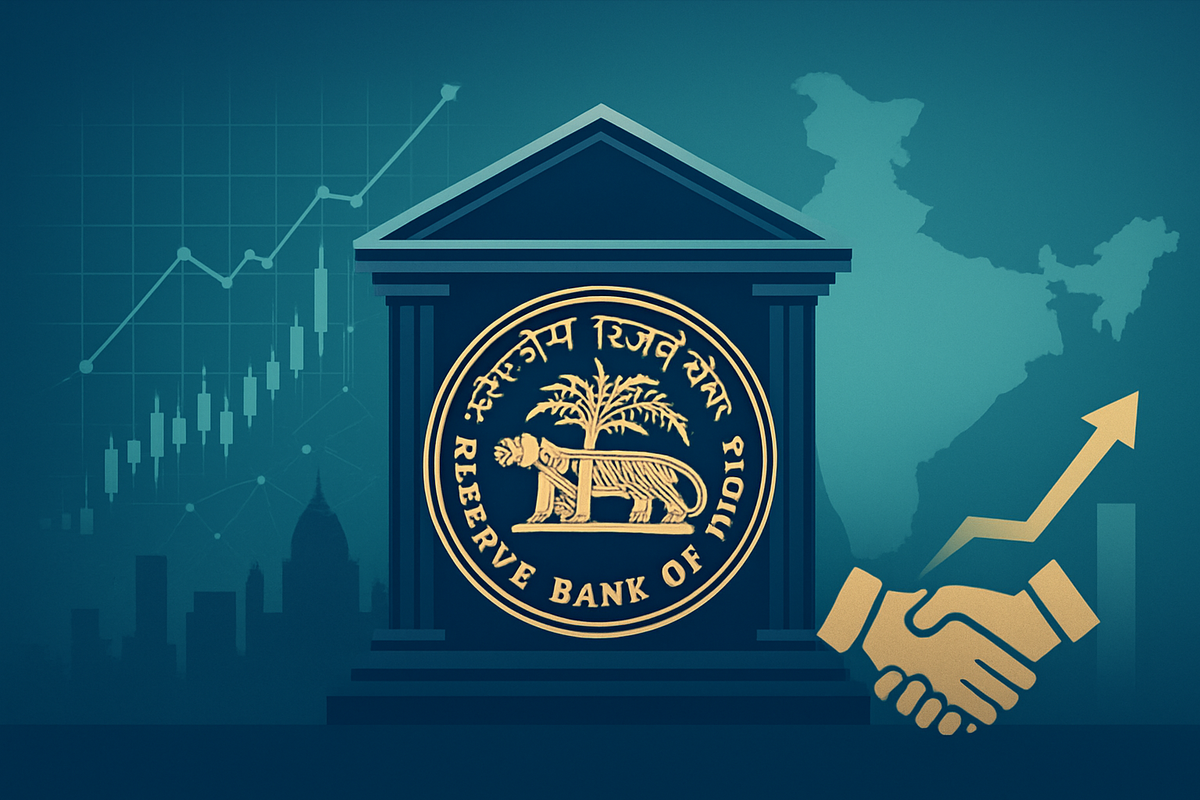
Mumbai, India – October 24, 2025 – The Reserve Bank of India (RBI) has unveiled a transformative set of draft guidelines, proposing significant changes to how Indian banks engage with the capital markets, particularly by allowing them to directly fund corporate acquisitions. These proposals, detailed in draft circulars issued in October 2025, signal a strategic pivot by the central bank to enhance financial stability, stimulate economic growth, and align India's banking sector with global best practices. The immediate implications are profound: a potential surge in domestic mergers and acquisitions (M&A) activity, a new competitive frontier for India's banking behemoths, and a looming disruption for the burgeoning private credit market.
The central bank's move is poised to be a game-changer for Indian corporates, who will now have access to a potentially cheaper and more readily available source of funding for their strategic buyouts. For banks, it opens up a lucrative new revenue stream, fostering incremental credit flow. However, the proposals also introduce stringent safeguards, reflecting the RBI's dual mandate of promoting growth while ensuring prudent risk management and maintaining the resilience of the financial system.
RBI's Bold Stroke: Unpacking the New Capital Market Directives
The RBI's comprehensive proposals encompass several key areas, most notably establishing an "enabling framework" for banks to finance corporate acquisitions and recalibrating overall capital market exposure limits. The new regulations are largely slated to come into effect from April 1, 2026, with broader regulatory alignments following in April 2027.
At the core of the new framework is a proposed overall Capital Market Exposure (CME) limit, mandating that a bank's total direct investments in capital markets, including acquisition finance, should not exceed 20% of its Tier 1 capital. This aims to ring-fence banks from excessive market volatility. Crucially, the RBI has carved out a new avenue for banks to finance corporate acquisitions, a segment previously largely restricted to private credit funds and foreign lenders. Under the new rules, banks may finance a maximum of 70% of the acquisition value, with the acquiring company required to inject at least 30% through equity. This funding is specifically for listed entities that demonstrate a satisfactory net worth and a three-year track record of profitability, with their annual returns publicly available. The acquisition value must also be supported by two independent valuations as per SEBI regulations. A critical safeguard is the stipulation that a bank's aggregate exposure towards acquisition finance cannot exceed 10% of its Tier 1 capital. Furthermore, eligible acquiring entities must be a body corporate, explicitly excluding financial intermediaries like Non-Banking Financial Companies (NBFCs) and Alternate Investment Funds (AIFs), and should not be related parties to the target company. Banks are also mandated to establish comprehensive internal policies on acquisition finance, detailing overall limits, eligibility criteria, security, margin, and robust risk management norms. The draft guidelines are currently open for public comments until November 21, 2025.
Beyond acquisition funding, the RBI has also moved to liberalize other capital market lending rules. The regulatory ceiling on lending against listed debt securities has been entirely removed, offering greater flexibility. Limits for lending by banks against shares have been significantly increased from ₹20 lakh to ₹1 crore per individual, while the permissible limit for IPO financing per person has been raised from ₹10 lakh to ₹25 lakh. In a strategic move to foster credit flow, the 2016 framework that disincentivized banks from lending to very large borrowers (with credit limits of ₹10,000 crore and above) has been withdrawn, with the RBI planning to manage systemic concentration risks through broader macroprudential tools.
These proposals, introduced in October 2025, set the stage for a phased implementation. While the immediate focus is on finalizing the acquisition funding guidelines post-public consultation, the RBI is also laying the groundwork for broader regulatory alignments. From April 2027, the central bank proposes adopting a forward-looking Expected Credit Loss (ECL) framework for provisioning, replacing the incurred-loss system, and implementing revised Basel III capital adequacy norms. These measures, aimed at bringing Indian banking practices in line with international standards, are expected to provide more nuanced risk weighting for various exposures, potentially reducing capital requirements for banks and freeing up capital for growth. Key players involved in this seismic shift include the Reserve Bank of India, major public and private sector banks such as State Bank of India (NSE: SBIN), HDFC Bank (NSE: HDFCBANK), and ICICI Bank (NSE: ICICIBANK), as well as corporate entities like Reliance Industries (NSE: RELIANCE) and Tata Motors (NSE: TATAMOTORS) that frequently engage in M&A. Initial market reactions have been largely positive, with analysts anticipating a boost to corporate activity and increased business for the banking sector, though private credit firms are bracing for increased competition.
Market Movers: Identifying the Potential Winners and Losers
The RBI's new framework is set to redraw the competitive landscape, creating clear winners and posing significant challenges for others within India's financial ecosystem.
The most evident winners will be India's large commercial banks. Institutions like State Bank of India (NSE: SBIN), HDFC Bank (NSE: HDFCBANK), ICICI Bank (NSE: ICICIBANK), and Axis Bank (NSE: AXISBANK) are poised to gain substantial new business opportunities by entering the acquisition financing market, a segment previously largely inaccessible to them. This move is "growth accretive," promising to boost their loan books, diversify revenue streams, and strengthen their relationships with corporate clients. The ability to offer acquisition finance at potentially lower interest rates due to their lower cost of funds will make them highly competitive. Furthermore, the increased limits for lending against shares and IPOs will enhance their retail and high-net-worth individual client offerings, driving incremental credit flow and fee income.
Conversely, the losers are likely to be the private credit funds and Non-Banking Financial Companies (NBFCs) that have thrived in the acquisition financing space. These entities, which previously filled the void left by banks' restrictions, will now face direct competition from banks with significantly lower funding costs. This could lead to pricing pressure, reduced market share, and a need for private credit players to re-evaluate their value proposition, potentially focusing on more complex or higher-risk deals that banks might still avoid. Additionally, highly leveraged unlisted entities seeking acquisition finance might find it harder to secure bank funding if they do not meet the strict eligibility criteria, such as profitability and satisfactory net worth, which are mandated for bank-funded acquisitions.
Wider Significance: A New Era for India's Financial Markets
This regulatory overhaul by the RBI transcends mere technical adjustments; it represents a significant step towards a more mature and robust Indian financial market, with far-reaching implications for corporate strategy, financial stability, and global integration.
The move to allow banks into acquisition finance directly addresses a long-standing demand from the industry and aligns India with global practices where banks play a central role in corporate M&A. This initiative fits into broader industry trends of financial deepening and strengthening domestic funding sources, reducing reliance on external or alternative financing channels. The potential ripple effects are considerable: the M&A landscape in India is expected to become more dynamic and competitive, enabling Indian strategics to better compete against foreign entities and private equity firms for domestic assets. This could spur consolidation in fragmented sectors and facilitate the growth of Indian conglomerates. For foreign investors, the increased liquidity and clarity in domestic acquisition funding could make the Indian market even more attractive, though they might face tougher competition from well-funded local players. Regulatory-wise, the RBI is clearly balancing growth imperatives with financial stability. The prescribed limits (20% for overall CME, 10% for acquisition finance within Tier 1 capital, 70% financing cap per deal) are crucial safeguards designed to mitigate potential risks of increased leverage and asset-liability management mismatches for banks. This proactive approach, coupled with the shift to an Expected Credit Loss (ECL) framework and revised Basel III norms, underscores the RBI's commitment to building a resilient banking sector capable of absorbing shocks and adhering to international prudential standards. Historically, Indian banks have faced stricter limitations on capital market exposures, a legacy of past market volatility. This current liberalization, while carefully calibrated, marks a departure, indicating the RBI's confidence in the banking sector's improved risk management capabilities and governance.
The Road Ahead: Navigating a Transformed Landscape
As the RBI's proposals move towards implementation, the coming months and years will be critical for all stakeholders to adapt to this transformed financial landscape.
In the short term, the focus will be on the finalization of the acquisition funding guidelines, particularly after the public consultation period concludes in November 2025. Banks will need to rapidly develop and refine their internal policies, risk assessment models, and operational frameworks to effectively enter the acquisition finance market by April 2026. This will involve significant investment in talent, technology, and due diligence capabilities. Corporates, meanwhile, will be evaluating their M&A pipelines, anticipating the availability of cheaper and more accessible funding. The private credit market will face immediate strategic pivots, potentially shifting towards niche segments, structured finance, or higher-yield opportunities where banks might still be hesitant.
Looking long-term, the impact could be profound. India's corporate M&A activity is expected to see a sustained boost, fostering industrial consolidation and potentially leading to more efficient capital allocation. The increased competition in acquisition finance could drive down borrowing costs for corporates, improving their balance sheets and investment capacity. Market opportunities may emerge in ancillary services such as M&A advisory, legal, and valuation services, as deal volumes increase. Challenges might include initial teething issues for banks in managing complex acquisition finance deals, and the need for continuous regulatory oversight to ensure the safeguards remain effective. Potential scenarios range from a smooth transition leading to a more vibrant and competitive M&A market, to a scenario where unforeseen risks emerge, requiring further regulatory adjustments. However, with the RBI's cautious and calibrated approach, the former seems more likely.
Conclusion: A New Dawn for Indian Banking and Corporate Growth
The Reserve Bank of India's proposed limits for banks' capital market exposure and, more significantly, the enabling framework for acquisition funding, mark a pivotal moment for India's financial markets. This strategic move is poised to unleash the full potential of domestic banks, transforming them from mere lenders into active facilitators of corporate growth and consolidation.
The key takeaways are clear: Indian banks are set to gain a substantial new revenue stream and solidify their position as primary financiers for domestic corporates. Indian businesses will benefit from enhanced access to funding, potentially driving a new wave of M&A activity and fostering economic expansion. While private credit players face an undeniable competitive challenge, the overall market is expected to become more dynamic and efficient. As the banking sector prepares for the implementation of these new rules by April 2026, coupled with the broader regulatory alignments in 2027, the Indian financial system is on a trajectory towards greater sophistication and resilience. Investors should closely watch how banks adapt their strategies, the evolving landscape of corporate M&A, and the RBI's ongoing monitoring of financial stability in the coming months. The era of a more integrated and powerful Indian banking sector has truly begun.
This content is intended for informational purposes only and is not financial advice






